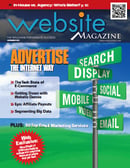Advertise the Internet Way

 As someone responsible for the success of a website, you likely know that Internet-based advertising - in all its variety - remains the most measurable means to raise awareness, encourage repeat visits and lest we forget, generate sales (conversions). That's not to say it's simple. The sheer number of channels, destinations, platforms and devices that must be considered when advertising a business and its products or services make it a daunting task for any enterprise.
As someone responsible for the success of a website, you likely know that Internet-based advertising - in all its variety - remains the most measurable means to raise awareness, encourage repeat visits and lest we forget, generate sales (conversions). That's not to say it's simple. The sheer number of channels, destinations, platforms and devices that must be considered when advertising a business and its products or services make it a daunting task for any enterprise.
What is often lacking in the ongoing, and, albeit, highly important conversation surrounding Internet advertising is some background (an overview if you will) of the available opportunities, techniques and tactics employed today by companies both large and small and across all verticals.
Without question, the ultimate objective of Internet advertising is to increase the likelihood of success for our digital enterprises, but only advertisers that focus on maximizing performance and leveraging the best available technologies can ever make it truly happen.
CHALLENGED IN THE GOLDEN AGE
First impressions matter in the digital realm. In online advertising, it's the moment when a potential customer encounters a brand being promoted on the search results page, through a display (banner) advertisement or even in the form of a recommendation (i.e. by an affiliate). The moment is undeniably an important one. Billions of these individual interactions with consumers take place every day. The challenge, however, is not in advertising everywhere users are, but advertising where and how the most significant impact is provided. To do that, enterprises need to advertise the "Internet way."
"I know half my advertising works; I just don't know which half..." That's the famous adage that has defined advertising for decades, until the advent of the Internet, of course. In this golden age, advertisers and marketers have more information available than ever before on what works, what doesn't, and most importantly, what can be improved (as well as what should be avoided). That's a rather epic shift.  Monitor Ad Opportunities and Threats
Monitor Ad Opportunities and Threats
Where there is money made (or spent) there is seemingly always a rogue to ruin the day. The Internet advertising industry is under a near constant threat - from privacy issues related to behavioral advertising to malware, rogue affiliates and more. Yet, there still remains immense opportunity when you know what to do and where to look. Stay up to date on important occurrences with Website Magazine's Internet Advertising Channel.
Once the dominion of those most creative among us, in the Web economy, advertising has changed. We no longer rely exclusively on those that are the most artistic or those that have an innate understanding of human motivation and further the human condition (sorry all you aspiring Don Drapers). Instead, our attention is focused "data" and understanding of past behavior and intent, and we are rigidly committed to performance. Advertising has changed and those that are educated on and committed to promoting their enterprises in today's dynamic digital ad landscape are poised to outperform competitors, both large and small.
An exploration of the current landscape of Internet advertising opportunities and methods, and some formal guidance to do so efficiently and effectively, can have any Web business advertising the Internet way. Let's begin by exploring what is arguably the most important and well-utilized advertising approach in the digital ecosystem today - paid search.
Search-Based Advertising
Paid search (CPC or PPC) advertising has been available to those interested in promoting their website for well over a decade. Many Web professionals and Internet advertising workers have grown up with search-based advertising and for many it is all they know or all they care to know; the reason? When done right, it is the best and most controllable driver of quality traffic to a website.
What differentiates search-based advertising from other methods is that it depends greatly on the level of user interest and the selection of keywords related to that interest. When a consumer enters a query into a search engine, an auction of sort takes place. In the past, those with the highest bid appeared in the first position of the results pages, but nowadays, many other factors come into play - most notably some variation on the concept of "quality score."
Unfortunately for us, how networks determine quality score is, for all intents and purposes, locked away in a black box, several important variables have been observed over time. Outside of the bid placed by an advertiser per keyword and their allotted budget, the relevance of that keyword to the landing page where a user/searcher ends up is crucial. Since "performance" is fundamental to advertising the "Internet way," count on the click-through rate (CTR) also playing a significant role.
However, today's search-based advertising isn't the same as that of yesteryear. As the Web evolves, so does the sophistication of the premier platforms. The takeaway from these variables is that effective search-based advertising does not stop at the selection of appropriate keywords. Landing page optimization and copywriting skills are clearly tied to the performance of search-based ad campaigns, so advertisers need to invest as much (if not more) in them to remain competitive.
Although search-based advertising is, for many, their first exposure to spending money to acquire website visitors, there are many other opportunities to explore.  REVVING UP SEARCH WITH RPM
REVVING UP SEARCH WITH RPM
A recent report from digital marketing intelligence provider, AdGooroo, shows how major retailers, including Target, Toys "R" Us and Victoria's Secret, are outperforming Amazon in paid SEM. Despite the fact that Amazon advertises on millions of keywords and has twice the AdWords spend as the next largest retailer (which happened to be Target), AdGooroo's research shows that outside of its strongest categories (books and other media) it is not always the dominant player. In reality, retailers with an established brand and specialized offering were able to reap significantly better results than Amazon in SEM. According to the report, retailers wishing to compete with Amazon in paid search should consider a key metric used by the search engines, Revenue per Thousand Impressions or RPM (RPM = CTR x CPC x 1000). AdGooroo's analysis of the SEM results of Amazon and competing retailers found that paid ad position on U.S. AdWords is highly correlated to the RPM that each competitor delivers to Google, and that the biggest lever for improving RPM is click-through rate.
DISPLAY ADVERTISING
Consider "display" as one of the original forms of Internet advertising. If the focus of your ad campaign is to raise awareness and establish your brand, credibility and authority, this is where you will turn. The downside of display ads, which most of you know all too well, is the issue of banner blindness.
The good news is that there's a renaissance in display advertising. Today, display advertisers not only have new styles of banners to develop, deploy and test (check out Website Magazine's post on numerous display formats, but also new technology that makes the impact of their visual advertisements more appealing to viewers than ever before. Enter "retargeting".
Retargeting (also known as remarketing) is not exclusive to display, but it is currently where it is most heavily utilized. Retargeted display ads enable advertisers to display their ads to users who had previously shown interest. On average, that leads to lower cost per conversion (particularly when retargeted display ads are aligned with search-based advertising). For example, let's say a prospective customer searches on Bing for a product you offer, and then visits your site, but leaves without purchasing. Using retargeting technology, a cookie is placed on the user. As they continue their search for more information on the product or its reviews, they will likely see a display ad for the exact product they initially viewed on your Web property.
There are numerous technologies such as that of retargeting that can help accelerate the success of a display advertising campaigns, but if an advertiser is leery of the obvious privacy implications, there still remain numerous opportunities to improve performance - from optimizing the creative with more meaningful calls-to-action or geo-targeting so that display ads show only to those in specific locales.  Email Advertising Opportunities
Email Advertising Opportunities
Even the mention of email and advertising in the same sentence elicits images of spammers inundating inboxes with messages for assorted products. Done the right way however, email advertising works. Read Website Magazine 5 Step Guide to Email Advertising Success.
SOCIAL ADVERTISING
The latest, if not greatest form of advertising at the moment is the channel-based approach of social advertising. Promoting messages on the popular social networks of the day is intriguing. But not everyone holds that sentiment. Take General Motors for example. The company made news when they pulled their ads from Facebook just days before the social media giant went public, citing their paid ads had little effect on bottom line performance.
Part of the problem, however, is that there are so many ways to define "social" that doing so is but a fool's errand. That being said of course, there are some players in the market that are defining the practice and providing an opportunity that would leave most Web advertisers breathless (virtually of course). And you know them well.
Both Twitter and Facebook have recently enhanced their ad products to provide more (and arguably better) opportunities and it shows just how much potential still resides in these wildly popular destinations.
In early September, Twitter released "interest targeting" for its advertisers, a technique which dramatically opens up the possibilities for helping to drive new business and a larger community from within that network. Not to be left out, Facebook unveiled several additional options for advertisers looking to promote their brand (and content) in the form of Promoted Posts and Sponsored Stories. In the past year, Facebook has invested heavily in its advertising opportunities, leaving many confused by the various options. Website Magazine has put together an online resource to help its readers in their Facebook advertising related decisions (WM's Facebook Ad Guide), which also provides several strategies to optimize performance.
PERFORMANCE (AFFILIATE) ADVERTISING
The final area to address, for Web enterprises truly interested in advertising the Internet way, is performancedriven affiliate marketing. In affiliate marketing, publishers (affiliates) promote the products or services (through text links or display ads) of advertisers and are compensated (i.e. paid commissions) only when the traffic sent to the advertiser results in some pre-defined, measurable result (completing a form, a sale, a sign-up, etc.). Affiliate marketing is big business, with hundreds of networks currently operating on the Web (some of which readers can find in the October 2012 issue of Website Magazine).
Affiliate marketing is ideal for advertisers looking to gain brand traction and grow their business without all the wasted clicks of paid search or wasted impressions of display. It's important to note, affiliate-based advertising is not without its complications and challenges. Careless affiliate advertising can cause irreparable damage to a brand (think SPAM). In addition, without a clear understanding of what affiliate commissions should be, investing in the model could be fruitless (if not wasteful).
Plus, while many advertisers are drawn toward affiliate marketing as a means to pay only when an action is created, a great deal of work needs to be done - from developing creative to managing and recruiting highperforming affiliates. Done well, however, it is possible to pay less, generate long-lasting traffic and increase sales - in some cases over night. It's truly possible to tap the full potential of the ‘Net with affiliate marketing and something every advertiser should consider.  The Truth About Mobile Ads
The Truth About Mobile Ads
A study released recently by mobile app marketing platform Trademob, analyzed 6 million-plus mobile advertising clicks on 10 of the biggest mobile ad networks and found that 22 percent of mobile ad clicks were "misclicks," or accidental clicks, and 18 percent were defined as "fraudulent." Both of which had a conversion rate of less than 0.1 percent.
GET STARTED ADVERTISING
(THE INTERNET WAY)
In the past few years, advertising has become less art and more science. In an economy where we value performance as much as creativity, that's the reality; and one Web professionals must accept. Whether you're heavily investing in any and all forms of Internet advertising, simply want to try something new, or are simply looking to drive more visits to and conversions for your Web enterprise, know that as it stands today, you can know exactly which half of your advertising works and can take steps to capture the rest over time.









